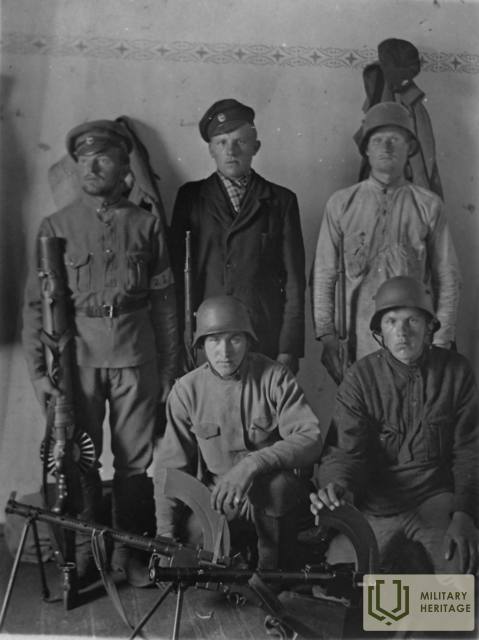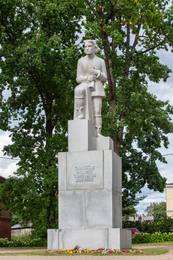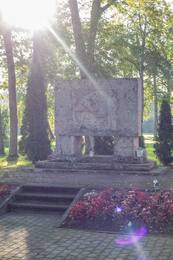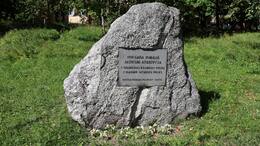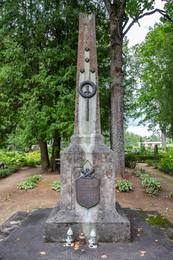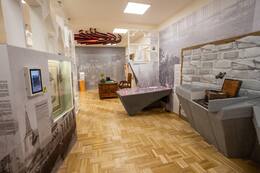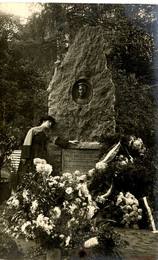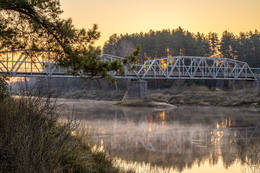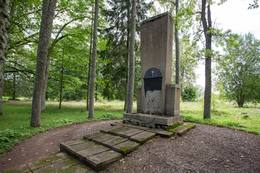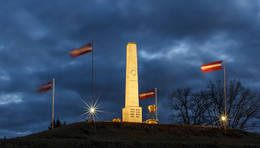Šiaurės Latvijos brigada I Nepriklausomybės karai
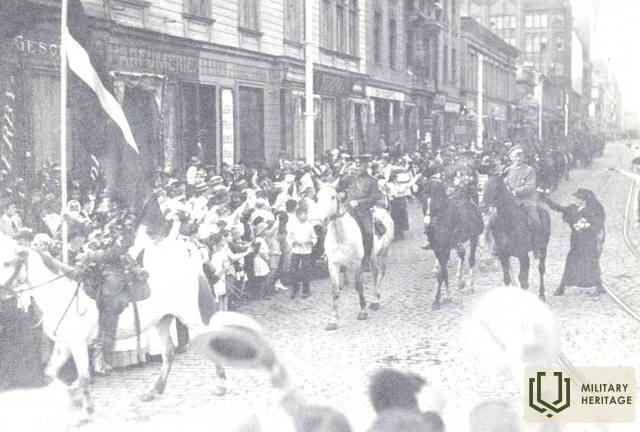
Šiaurės Latvijos brigada buvo Latvijos karinis darinys, veikęs Latvijos nepriklausomybės karo metu 1919 m. vasario ir kovo mėn., Latvijos ir Estijos vyriausybių atstovų susitarimu, Estijos teritorijoje ir Šiaurės Vidžemės regionuose, kuriuos išlaisvino Estijos kariuomenė.
Vasario 3 d. Latvijos gynybos ministras Janis Zālītis paskyrė Jorgį Zemitaną visų Latvijos kariuomenės Estijoje ir Šiaurės Latvijoje organizatoriumi ir vadu, o inžinierių Marką Gailītį – jo įgaliotuoju atstovu civiliniais reikalais. Per trumpą laiką buvo suformuotas 1-asis Valmieros pėstininkų pulkas, kuris kovo pabaigoje išėjo į frontą. Kovo 31 d. Estijos armijos vyriausiojo vado įsakymu buvo įkurta Šiaurės Latvijos brigada, vadovaujama pulkininko Zemitano, kurios štabas buvo Tartu. Zemitanas savo padėjėju paskyrė pulkininką leitenantą Edvardą Kalninį, kuris taip pat vadovavo artilerijai. Štabo viršininkas buvo pulkininkas leitenantas Voldemaras Ozolsas. Iki 1919 m. liepos mėn. brigada logistikos ir operacijų požiūriu buvo pavaldi Estijos ginkluotųjų pajėgų štabui ir Estijos armijos vyriausiajam vadui.
1919 m. gegužės pabaigoje Šiaurės Latvijos brigadą sudarė 1-asis Valmieros pulkas su 1100 kareivių, 2-asis Cėsių pulkas su 1700 kareivių, partizanų pulkas su 200 kareivių, viena eskadra su 50 kavaleristų, 1-oji Valmieros ir 2-oji Cėsių artilerijos baterijos su 210 kareivių ir rezervinis batalionas su 320 rezervistų. Iš viso ją sudarė 110 karininkų ir 3400 kareivių. Brigada neturėjo ginklų, daugelis kareivių iš pradžių dėvėjo civilius drabužius ir batus arba vaikščiojo basomis.
Nuo 1919 m. balandžio pradžios Šiaurės Latvijos brigada kartu su Estijos armija kovojo su bolševikų Raudonąja armija, siekdama išlaisvinti Vidzemę. Birželį Šiaurės Latvijos brigada dalyvavo Cėsių mūšyje prieš Baltijos landesverą ir Geležinę diviziją, kuriame kartu su Estijos armija iškovojo pergalę. Liepos 3 d. pasibaigus Strazdumuizos paliauboms, liepos 6 d. Šiaurės Latvijos brigada įžengė į Rygą.
1919 m. liepą, suformavus vieningą Latvijos armiją, Šiaurės Latvijos brigada buvo pertvarkyta į Vidžemės diviziją.
Daugiau informacijos šaltinių
Ērikas Jėkabsonsas. Latvijos nepriklausomybės karas. Latvijos laikinosios vyriausybės ir jos ginkluotųjų pajėgų kova už Latvijos nepriklausomybę nuo 1918 m. lapkričio 18 d. iki 1920 m. rugpjūčio 11 d. – Nacionalinė enciklopedija: https://enciklopedija.lv/skirklis/22216-Latvijas-Neatkar%C4%ABbas-kar%C5%A1
Šiaurės Latvijos brigada. Vikipedija. https://lv.wikipedia.org/wiki/Zieme%C4%BClatvijas_brig%C4%81de
Kova už laisvę: Latvijos nepriklausomybės karas (1918–1920 m.) Latvijos valstybinio istorijos archyvo dokumentuose, 1 dalis, 1918 m. lapkričio 18 d. – 1919 m. balandžio 16 d., sudar. Ē. Jēkabsons ir J. Šiliņš, Ryga, Latvijos nacionalinis archyvas, 2019 m.
„Kova už laisvę: Latvijos nepriklausomybės karas (1918–1920 m.) Latvijos valstybinio istorijos archyvo dokumentuose“, 2 dalis. 1919 m. balandžio 16 d. – liepos 10 d., sudar. Ē. Jēkabsons ir J. Šiliņš, Ryga, Latvijos nacionalinis archyvas, 2019.
Susijusi laiko juosta
Susijusios vietos
Paminklas „Talavos trimitininkas“
Įsikūręs Rūjienos centro aikštėje.
Trijų metrų aukščio senovės Latvijos gvardijos kareivio atvaizdas, išdrožtas iš pilko suomiško granito, vadinamas „Tālavo trimitininku“, pastatytas ant trijų metrų aukščio granito pjedestalo, tačiau bendras paminklo aukštis siekia 7,5 metro. Pradiniuose eskizuose ir modeliuose K. Zemdega į kario rankas įdėjo kardą, kuris vėliau buvo pakeistas trimitu. Paminklas buvo atidengtas 1937 m. rugpjūčio 15 d.
Šis paminklas atspindi sunkią mūsų valstybės ir kariuomenės kūrimosi situaciją, taip pat šių įvykių vertinimą. Iškart po Latvijos valstybės paskelbimo prasidėjo Raudonosios armijos puolimas, o laikinoji Karlo Ulmanio vyriausybė rado prieglobstį Liepojoje. 1919 m. vasarį, padedant Estijos armijai, prasidėjo Latvijos išlaisvinimas iš šiaurės, o Rūjienos apylinkėse įvyko pirmosios Tērbate besiformuojančių Latvijos kariuomenės mobilizacijos, kurios, vadovaujamos pulkininko Jorgio Zemitano, tapo Šiaurės Latvijos brigada. Šiaurės Latvijos brigada kovojo ne tik su bolševikais, bet ir su landesveru bei Geležine divizija Cėsių mūšiuose. Rūjienos apylinkėse mobilizuoti Šiaurės Latvijos kariai kovojo ir vėlesniuose Nepriklausomybės karo mūšiuose. Po karo pagrindiniai pergalės laurai atiteko generolui Jāniui Balodžiui ir jo vadovaujamai Pietų Latvijos brigadai, tačiau Šiaurės Latvijos brigada dažnai buvo pamirštama. Rūjienoje planuojamas Šiaurės Latvijos brigados paminklas taip pat užtruko ilgai, o 1937 m. atidengtas paminklas oficialiai buvo reklamuojamas kaip Rūjienos krašto išlaisvinimo ir žuvusių karių atminimo paminklas, nepaminint, kad visi Šiaurės Latvijos brigados pulkai savo ištakas turėjo Rūjienoje.
Paminklas yra ne tik populiari turistų lankoma vieta Latvijos ir Estijos turistams, tam tikru mastu tapusi atspirties tašku norint aplankyti keletą kitų Nepriklausomybės karo memorialinių vietų Rūjienoje, bet „Tālavas tauretājs“ yra ir sustojimo vieta įvairaus lygio Estijos ir Latvijos valstybės bei vietos valdžios pareigūnams.
Rūjienos išlaisvinimo ir žuvusių karių paminklas, geriau žinomas kaip „Tolamas tauretājs“ (Tolimas ragas), 1998 m. spalio 29 d. buvo įtrauktas į valstybės saugomų kultūros paminklų sąrašą kaip nacionalinės svarbos meno paminklas (paminklo apsaugos registracijos numeris 4522).
Šiaurės Latvijos išvaduotojų paminklas
Įsikūręs Plāčio centre, netoli Inčukalno–Valko greitkelio (A3). Šalia autobusų stotelės ir Straupes bendruomenės centro.
Matomas Teodoro Zaļkalnso sukurtas paminklas Šiaurės Latvijos išvaduotojams Cėsių mūšyje 1919 m.
Ant trijų pakopų pagrindo pastatyti du travertino stulpai, ant kurių remiasi travertino blokas. Jo priekyje bareljefe pavaizduotas arklys, pakinkytas prie plūgo, ir artojas, kuris dešinėje rankoje laiko vadžias, o kairėje – kardą. Paminklo gale iškaltas tekstas, kuris baigiasi poeto Eduardo Virzos eilutėmis:
Šiaurės Latvijos išvaduotojams
KOL ŠIAME LAUKE PASĖJAMAS VIENAS GRŪDAS
Būsite giriami ir gerbiami
Paminklas buvo atidengtas 1931 m. lapkričio 8 d. Atidaryme dalyvavo prezidentas Albertas Kviesis.
Atminimo akmuo Alūksnės išvaduotojams
Įsikūręs Alūksnėje, Helēnas ir Alsviķu gatvių sankirtoje.
Atminimo akmuo buvo atidengtas 1999 m. gegužės 29 d., minint Alūksnės išvadavimo 80-ąsias metines. Akmens drožybos darbus atliko skulptorius Ainārs Zelčs.
1919 m. kovo 31 d. Tartu mieste buvo įkurta Šiaurės Latvijos brigada, kurios užduotis buvo išlaisvinti Vidžemę ir Latgalą. Brigadą sudarė jungtinis 1-asis Valmieros ir 2-asis Cėsių pėstininkų pulkai, vėliau ir Šiaurės Latvijos partizanų pulkas, du kavalerijos eskadrilės ir dvi artilerijos baterijos. Gegužės 26 d. šios pajėgos užėmė Valmierą, tačiau gegužės 27 d. 1-asis Valmieros pėstininkų pulkas kartu su 2-uoju Estijos kavalerijos pulku pradėjo puolimą Alūksnės kryptimi. Bolševikai nesugebėjo atremti tolesnių atakų, todėl 1919 m. gegužės 29 d. Alūksnė buvo išlaisvinta.
Paminklas Nepriklausomybės kare žuvusiems kariams
Įsikūręs Bertulio kapinėse.
Galima pamatyti paminklą Latvijos Nepriklausomybės kare žuvusiems kariams.
Atidengtas 1934 m. rugpjūčio 4 d. Paminklas pastatytas pagal Teodoro Šķinčio ir Ludžio Švalbės projektą.
Paminklo priekyje, simbolizuojančiame pergalės triumfą, pritvirtintas bronzinis kardas, ąžuolo lapo vainikas ir keturios žvaigždės (auseklīši), simbolizuojančios keturis istorinius Latvijos regionus – Vidžemę, Kuržemę, Žiemgalą ir Latgalą.
Kitoje pusėje, simbolizuojantis praeities kančių kelią, prie obelisko pritvirtintas bronzinis kryžius, kuris iš pradžių buvo apvyniotas spygliuotos vielos vainiku. Vainikui naudojama spygliuota viela buvo atgabenta iš Mirties salos.
Paminklas buvo restauruotas 1989 m. vasarą, o visos bronzinės dalys buvo pagamintos nuo nulio.
Ekspozicija „Valka – Latvijos Nepriklausomybės lopšys“
Valkos kraštotyros muziejus yra Valkoje, dešinėje Rygos gatvės pusėje, istoriniame Vidžemės parapijos mokyklos mokytojų seminarijos pastate. Nuo 1853 iki 1890 m. pastate veikė Vidžemės parapijos mokyklos mokytojų seminarija. Iki 1881 m. jai vadovavo Janis Cimze, mokytojas ir Latvijos chorinės kultūros pradininkas. Uždarius mokyklos mokytojų seminariją, pastatas 80 metų tenkino įvairius švietimo, kultūros ir buities poreikius. Nuo 1970 m. pastate įsikūręs Valkos kraštotyros muziejus. Nuolatinė muziejaus ekspozicija „Valka – Latvijos nepriklausomybės lopšys“ pasakoja apie socialinius ir politinius įvykius Valkoje nuo 1914 iki 1920 m., kai Latvija tapo nepriklausoma valstybe. Ekspozicija atspindi pasirengimą Latvijos valstybės įkūrimui ir Šiaurės Latvijos brigados formavimui Valkoje. Parodoje, perteikiant keturias prasmes – Kelį, Tarybą, Būstinę ir Namus, daugiausia dėmesio skiriama temoms, susijusioms su Valkos miestu, pabėgėliais, Latvijos ūkininkų sąjungos įkūrimu (1917 m.),
Latvijos laikinoji nacionalinė taryba (1917 m.), Latvijos laikinasis nacionalinis teatras (1918 m.), Laikinoji Sovietų Latvijos vyriausybė, žinoma kaip Iskolat, Šiaurės Latvijos brigada (1919 m.) ir generolas Pēteris Radziņš. Be tradicinių kolekcijų eksponavimo būdų, parodoje naudojami interaktyvūs multimedijos sprendimai.
Paminklas karinio jūrų laivyno leitenantui L.k.o.k. Vilis Gelbes (1890-1919)
Įsikūręs Limbaži Jūros gatvės kapinėse, Jūros g. 56, Limbaži
Eksponuojamas paminklas, kurį 1922 m. rugsėjo 10 d. atidengė tuometinis Latvijos prezidentas Janis Čakste, su poeto Vilio Plūdonio dedikacija Viliui Gelbui:
„Mano žmonės, kurie eina pro mane, dega meile savo tėvynei,
"Dėl savo mylimos tėvynės pažadu savo gyvybę."
Vilis Gelbė (1890–1919) gimė Kurše, Zemytės valsčiuje, tačiau buvo glaudžiai susijęs ir su Limbažių puse, nes prasidėjus Latvijos nepriklausomybės karui, iš Sankt Peterburgo grįžo į Latviją ir įstojo į Šiaurės Latvijos brigadą.
1919 m. gegužę V. Gelbis vadovavo Limbažiuose, tapo srities karo komendantu ir sugebėjo įkvėpti vietos vyrus ir net labai jaunus berniukus stoti į kariuomenę.
Tuo metu V. Gelbės veikla Limbažiuose ir apylinkėse buvo labai reikšminga; jo pareigos apėmė ne tik tvarkos palaikymą mieste ir apylinkėse, bet ir mobilizaciją, kareivių ir arklių aprūpinimą maistu bei daugelio kitų klausimų, kurie negalėjo būti įtraukti į įsakymus ir instrukcijas, sprendimą. Jo organizuota komendanto komanda veikė kaip koordinuotas mechanizmas, suteikiantis Šiaurės Latvijos brigadai kuo efektyvesnę pagalbą. Komendanto komanda ypatingais atvejais eidavo į pagalbą reguliariajai armijai, o naujiesiems kariams rodydavo pavyzdį. V. Gelbė buvo pirmasis Latvijos armijos karininkas, pasiūlęs savo pavaldinius apdovanoti III laipsnio Imantos ordinu. Ordino tuo metu dar nebuvo. Imantos vardas viešumoje pasirodė tik 1920 m. kovo 20 d., kai saugumo ministrui Kārliui Ulmaniui buvo pateiktas siūlymas dėl karinio ordino įsteigimo. Tačiau ordinui buvo pasirinktas Lāčplēsio vardas.
Cėsių mūšio metu Vilis Gelbė žuvo 1919 m. birželio 19 d. žvalgybos misijos metu. Vėliau Gelbė buvo apdovanotas Lačplėšio karo ordinu, tačiau istorikai mano, kad jo indėlis nebuvo tinkamai įvertintas. Taip yra daugiausia dėl Gelbės narystės Šiaurės Latvijos brigadoje.
Vadinamoji Pietų Latvijos brigada, kuriai iš pradžių vadovavo Oskaras Kaplakas, o vėliau – Janis Baložas, varžėsi su Šiaurės Latvijos brigada, kuriai vadovavo Jorgis Zemitānsas.
Geležinis tiltas per Gaujos upę Valmieroje
Įsikūręs Valmieroje, netoli Gimės gamtos tako Leono Paegles gatvėje.
Plieninio karkaso geležinis tiltas per Gaujos upę buvo pastatytas 1911 m. Jis sujungė 114 km ilgio maršrutą Ainaži–Valmiera–Smiltenė, kuris paskutinį kartą buvo baigtas statyti 1971 m.
Po Rygos išlaisvinimo 1919 m. gegužės 22 d., dalis sovietinės Latvijos armijos atsitraukė visu frontu, neparodydamos jokio rimtesnio pasipriešinimo. Gegužės 26 d. Estijos nacionalinė armija ir Šiaurės Latvijos brigada, vadovaujama pulkininko Jorgio Zemitano, užėmė Valmierą. „Apie šeštą valandą popiet didžiūnai susprogdino geležinkelio tiltą. 19:50 jie taip pat padegė abu medinius tiltus. Tai nesutrukdė Estijos kariuomenei tos pačios dienos vakare įžengti į miestą iš Valmieros dvaro* [...]“
Šiandien geležinis tiltas yra mėgstama poilsio ir pasivaikščiojimo vieta bei „Žaliojo geležinkelio“ dviračių maršruto atkarpa.
* Pirmiausia atvyko 6-ojo Estijos pėstininkų pulko kadetų kuopa, lydima kelių šarvuočių.
Paminklas Pirmajame pasauliniame kare ir Latvijos nepriklausomybės kare žuvusiems kariams
Įsikūręs Bažnyčios gatvėje priešais Šv. Onos bažnyčią.
Galima pamatyti paminklą Pirmajame pasauliniame kare ir Latvijos Nepriklausomybės kare žuvusiems kariams.
1923 m. gegužės 1 d. priešais Mazsalacos liuteronų bažnyčią buvo pasodinta „Didvyrių giraitė“, kurioje kiekvienam žuvusiam kareiviui buvo skirtas ąžuolas. Pasak Likerto, iš viso buvo pasodinti 97 ąžuolai – 23 žuvusiems Nepriklausomybės kare ir 74 žuvusiems Pirmajame pasauliniame kare. Tačiau to meto spaudoje buvo minima, kad buvo pasodinti 106 ąžuolai.
1927 m. rugpjūčio 21 d. „Didvyrių giraitėje“ buvo atidengtas architekto Paulo Kundzinio suprojektuotas betoninis paminklas, kurio statyboje dalyvavo ir skulptorius Vilhelmas Treijsas.
Paminklas yra šalia Mazsalacos Šv. Onos bažnyčios, kuri buvo pastatyta specialiai parinktoje vietoje, kad jos lieknas (58,6 m), gražus bokštas būtų matomas iš tolo. Bažnyčia yra gerai išsilaikiusi, nes sovietmečiu nebuvo nei sunaikinta, nei pritaikyta jokiems kitiems tikslams.
Paminklas 7-ojo Siguldos pėstininkų pulko kariams, žuvusiems Latvijos Nepriklausomybės kare
Įsikūręs Alūksnės ežero pakrantėje, Pskevo (Kolbergo) gatvės pusėje.
1923 metų birželio 22 dieną Latvijos prezidentas Jānis Čakste atidengė paminklą žuvusiems 7-ojo Siguldos pėstininkų pulko kariams. Paminklą sukūrė dailininkas Jūlijs Miesnieks.
Pulko kariai taip pat gerino ir tvarkė paminklo aplinką. Kareiviai prie paminklo rinkosi pulko metinių minėjimo išvakarėse, kai uždegdavo šventąją ugnį, taip pat pulko metinių dieną po parado ir užtarimo Garnizono kapinėse.
1940/1941 m. bolševikai pašalino ir sunaikino lentą, tačiau pats paminklas buvo nugriautas 1953 m., o jo akmenys įmūryti į kareivinių pastato kampinius pamatus.
Prasidėjus Atbudimui, 1989 m. rudenį buvo sutvarkyta teritorija aplink sunaikintą paminklą, kuris tuo metu dar buvo SSRS okupacinių kariuomenės teritorijoje. Lapkričio 11 d. buvusioje paminklo vietoje buvo atidengtas laikinas granito memorialas su išgraviruotu tekstu: „7-ojo Siguldos pėstininkų pulko paminklas šioje vietoje bus atkurtas 1989 m. lapkričio 11 d.“
Alūksnės brolių kapinių komiteto vadovo U. Veldre iniciatyva buvo pradėti paminklo restauravimo darbai, o restauruotas paminklas atidengtas 2009 m. spalio 16 d.
Skirtingai nuo originalaus paminklo, ant obelisko vietoj pulko krūtinės šarvų buvo sukurtas kryžius. Abu paminklo reljefus nukalė skulptorius Ainārs Zelčs. Restauruotam paminklui panaudotos tiek 22 originalių obelisko blokų dalys, rastos Nacionalinių ginkluotųjų pajėgų pėstininkų mokyklos teritorijoje, tiek naujai pagaminti blokai.
2019 m. birželio 20 d., minint 7-ojo Siguldos pėstininkų pulko šimtmečio jubiliejų, paminklo kalnelio papėdėje buvo atidengta pulko paminklo atminimo vieta ir granito atminimo lenta žuvusiems dalinio kariams, ant kurios išgraviruotas tekstas: „Jūsų stipri dvasia visada su mumis...“. Atminimo vieta pastatyta Nacionalinių ginkluotųjų pajėgų Pėstininkų mokyklos personalo paaukotomis lėšomis.
Susijusi istorija
Šiaurės Latvijos armijos įkūrimo Rūjienos pusėje fragmentas
Šiaurės Latvijos armija buvo Latvijos karinis darinys, veikęs Latvijos nepriklausomybės karo metu, suformuotas nuo 1919 m. vasario 3 d. iki kovo 31 d. Estijos teritorijoje ir Šiaurės Vidžemės regionuose, kuriuos išlaisvino Estijos armija. Iki 1919 m. liepos mėn. brigada logistikos ir operacijų požiūriu buvo pavaldi Estijos ginkluotųjų pajėgų štabui ir Estijos armijos vyriausiajam vadui. Vėliau ji buvo sujungta su Pietų Latvijos brigada, sudarant Latvijos armiją.
Cėsių mūšio pradžia, eiga ir pabaiga
Pergalė Cėsių mūšyje turėjo tapti lūžio tašku Latvijos ir Estijos kovoje už savo šalies nepriklausomybę. Ši pergalė sustabdė Andrijevo Niedros vyriausybės ir vokiečių generolo Rüdigerio fon der Golco planus užkariauti Pabaltijį. Vietoj to, Liepojoje savo veiklą atnaujino Karlio Ulmanio vadovaujama Laikinoji Latvijos vyriausybė.
Apie nacionalinį patriotą pirmąjį leitenantą Vilį Gelbį
Pulkininko leitenanto Vilio Gelbės (1890–1919) likimas atspindi sunkią situaciją kuriant mūsų valstybę ir kariuomenę, taip pat šių įvykių vertinimą.
1918 m. lapkričio 18 d. paskelbus Latvijos valstybę, prasidėjo Latvijos nepriklausomybės karas ir ginkluotųjų pajėgų kūrimo darbai. Pirmosiose Latvijos savanorių kareivių gretose buvo Kurše gimęs jūrų leitenantas Vilis Gelbė.
Apie pirmąjį Latvijos armijos vyriausiąjį vadą Dāvidą Sīmansoną
Knygos „Latvijos armijos vadai“ esė įtikina, kad istorijai didelę įtaką daro konkretūs asmenys. Nors svarbiausių istorinių įvykių epicentre jie buvo trumpą laiką, tikri Latvijos patriotai, turėdami didelę karinę patirtį, sugebėjo daug nuveikti formuojant ir stiprinant Latvijos kariuomenę bei istorinių įvykių lūžio taškuose.
Ši istorija yra apie pirmąjį Latvijos armijos vyriausiąjį vadą Dāvidą Sīmansoną (1859–1933).
7. Siguldos pėstininkų pulko formavimas
1919 m. birželio 20 d. Naukšėnų dvare, netoli Rūjienos, Šiaurės Latvijos brigados vado pulkininko Jorgio Zemitano įsakymu pradėtas formuoti 7-asis Siguldos pėstininkų pulkas. Iš pradžių iš Šiaurės Latvijos brigados rezervinio bataliono buvo suformuota nedidelė kovinė grupė, susidedanti iš 22 karininkų ir 1580 kareivių, kuri, pagerbiant pirmąjį vadą Oskarą Dankerį, buvo pavadinta Dankerio divizija. Po kelių dienų divizija buvo įtraukta į 3-iojo Jelgavos pulko 2-ąjį batalioną, o rugpjūčio 23 d., pridėjus kuopą, – į 7-ąjį Siguldos pėstininkų pulką.




